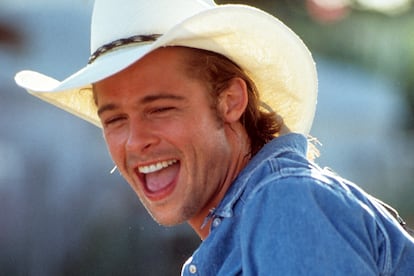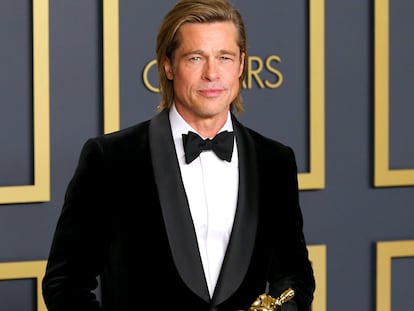60 years of Brad Pitt: How the college dropout got his first big break in Hollywood
The actor had his first major opportunity in the industry after being part of the supporting cast of the now classic ‘Thelma & Louise’

When Brad Pitt got on the stage of the Dolby Theater in Hollywood to accept his first Oscar for acting in 2020 (Best Supporting Actor for Once Upon a Time in Hollywood), he recalled the two people that gave him his first big opportunity in the industry 30 years prior, which led to a fruitful career: Ridley Scott and Geena Davis.
In the late eighties, Ridley Scott — one of Hollywood’s highest-profile filmmakers at the time — was working on a script written by then-music video producer Callie Khouri. The name of the story was Thelma & Louise and followed two friends who embark on a road trip. At first, Scott wanted to produce the film and find a suitable director; however, he decided to direct it after being convinced by Michelle Pfeiffer, who was originally chosen to star next to Jodie Foster.
Both actresses abandoned the project as pre-production extended. After considering Meryl Streep and Goldie Hawn, Susan Sarandon and Geena Davis — who had pursued the role for almost a year — were chosen for the roles. As the casting process continued, Scott and his team began looking for an actor to play J.D., an attractive young drifter who gets involved with Davis’ character, Thelma.
In recent interviews, Davis has revealed several names that auditioned for the role of J.D.: George Clooney, Mark Ruffalo, Grant Show, and others were considered to take the part. However, a blonde actor from Oklahoma named Brad Pitt ultimately won the role.
“There were five candidates for the part,” explained Davis in an interview with Entertainment Weekly. “They wanted me to read with them so they could see the chemistry. But they didn’t ask me afterwards what I thought about them.” The actress then offered to give her suggestion. Every actor but Pitt had brown hair, so, when asked whom she preferred, she just said: “The blonde one! Hello!” Billy Baldwin had been reportedly cast for the role but he and his replacement dropped out of the film.

At the time, Pitt had been trying to break out in Hollywood for a few years. After quitting university he moved to Los Angeles and started to take acting lessons which led to him starting to play small and uncredited parts in movies and TV. Although he had his first leading role in a Yugoslavian-American production called The Dark Side of the Sun in 1988, the film was shelved because of the Croatian War of Independence. With some TV guest appearances and supporting roles, he was still waiting for his “big break,” which came after auditioning with Genna Davis. “He’s so charismatic and so incredibly talented that I was screwing up his audition,” she also admitted during the Graham Norton Show as she was re-telling the story.
Pitt told W Magazine that he didn’t get the part immediately. He had to try for the part three times until he finally won it. As for the role, it wasn’t a big part, but his screen time was enough for him to show audiences what he could do. “When you look at him, he’s like a really good-looking American sexy boy, and he could’ve gone on to a TV series,” said Susan Sarandon to EW. “But there’s something about him that knew how to take that and make it really interesting. You can tell by other parts of the movie that he was something special.”
One of the most remembered scenes from the movie is the love scene between Pitt’s and Davis’ characters, a sequence that is now called iconic, and which turned the actor into a sex symbol. In fact, Ridley Scott worked hard on that scene in order to really show the intimacy between the characters. Sarandon recalled the filming of the scene to Davies during an ET talk: “I remember Geena, you coming back after the scene the next day and saying, ‘Honey, they’re maybe not looking at our lighting, but Ridley was in there spritzing him down and the lighting was on him.’ They made sure he was getting every single ounce of hotness or whatever of Brad Pitt that could be.” Pitt reflected on the scene: “Geena was so sweet and kind and delicate. That love scene, I think, went on for two days of shooting. She took care of me.”
However, Pitt’s looks weren’t the only thing that audiences discovered while seeing Thelma & Louise. After the theatrical release, the audience was in awe of Pitt’s work. Sarandon said: “When I saw the film for the first time, he did so much more with that part than what was on the page that I thought, ‘This guy is special.’ And he’s a character actor… what he added was really clever. So, that was the first time I thought, ‘Well, this guy is really special.’ Because he brought a lot of stuff to it that wasn’t in the script.”
Thelma & Louise had its premiere at the Cannes Film Festival on May 20, 1991, and quickly was critically acclaimed for its lead performances, its feminist premise, and Scott’s direction. For Pitt, the film was his big break. That same year he took the lead role in Johnny Suede, and in 1992 he starred in Cool World. The rest of the decade he released several hits — including Interview with the Vampire, Seven, 12 Monkeys, Fight Club and Seven Years in Tibet — that made him one of the world’s most famous actors.
“I’m really grateful to Ridley Scott and Geena, who gave me that shot, because that was the big league,” he told The Sun in an interview in 2020. “I had nothing to show for myself, except for my work as an extra, and they took a chance on me.” That was only the beginning for the actor, who has now a career of more than 30 years.
Sign up for our weekly newsletter to get more English-language news coverage from EL PAÍS USA Edition
Tu suscripción se está usando en otro dispositivo
¿Quieres añadir otro usuario a tu suscripción?
Si continúas leyendo en este dispositivo, no se podrá leer en el otro.
FlechaTu suscripción se está usando en otro dispositivo y solo puedes acceder a EL PAÍS desde un dispositivo a la vez.
Si quieres compartir tu cuenta, cambia tu suscripción a la modalidad Premium, así podrás añadir otro usuario. Cada uno accederá con su propia cuenta de email, lo que os permitirá personalizar vuestra experiencia en EL PAÍS.
¿Tienes una suscripción de empresa? Accede aquí para contratar más cuentas.
En el caso de no saber quién está usando tu cuenta, te recomendamos cambiar tu contraseña aquí.
Si decides continuar compartiendo tu cuenta, este mensaje se mostrará en tu dispositivo y en el de la otra persona que está usando tu cuenta de forma indefinida, afectando a tu experiencia de lectura. Puedes consultar aquí los términos y condiciones de la suscripción digital.
More information
Archived In
Últimas noticias
Most viewed
- Sinaloa Cartel war is taking its toll on Los Chapitos
- Oona Chaplin: ‘I told James Cameron that I was living in a treehouse and starting a permaculture project with a friend’
- Reinhard Genzel, Nobel laureate in physics: ‘One-minute videos will never give you the truth’
- Why the price of coffee has skyrocketed: from Brazilian plantations to specialty coffee houses
- Silver prices are going crazy: This is what’s fueling the rally











































